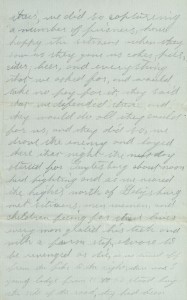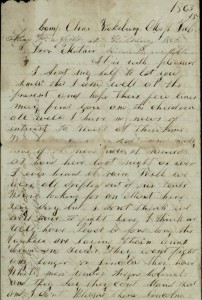

“… as we neared the heights north of Gettysburg met civilians, men, women, and children fleeing for their lives, every man grated his teeth and… swore to be revenged or die…” (detail from William W. Edgerton’s Gettysburg diaries)
The hits just keep on coming over at the University of Houston Digital Library with last week’s publication of the Civil War Letters digital collection.
With the flurry of additional items added to existing collections along with new collections going live over at the Digital Library, you may have just missed some of the new ground being broken for military historians or those with perhaps just a passing interest in Civil War history.
Combined from the M.L. Calk Civil War Letters, the W.D. Lowther Civil War Letters, and the earliest accessioned collection in our Military History collections, the William W. Edgerton Civil War Letters, this digital collection pulls together multiple sources providing researchers with a new view of these artifacts as well as new tools to answer that gnawing question of, “Where?”
When the location of a letter’s origin is known, a new map component accompanying this collection allows us to identify visually where the letter was written. We think Civil War buffs will appreciate this new functionality and the potential for future researchers, in this collection or those to come, is immediate and sure to be invaluable for those whose research interests are pinned to particular regions or desire to visually explore artifacts by locale.
Included among these digital items are letters belonging to both Confederate soldiers (Calk and Lowther) as well as correspondence from the Union side of the conflict (Edgerton). Quiet moments of correspondence cutting through the cacophony of warfare have long been prized by researchers as rich veins of information and insight. The correspondence of these brothers in arms is no different, offering personal views throughout.
Examples include bits like Lowther relating to his fiance, Phronie, the ordeal of a six day march or Edgerton’s writings allowing us a look into his diaries from the Battle of Gettysburg. M.L. Calk on the other hand, who served with the 23rd Alabama Volunteer Infantry Regiment, writes home to his mother from Vicksburg, Mississippi in February 1863 as he attempts to ease her mind, assuring her that he does not think he will have to fight, certain there will be “peace before long,” as the Yankees are “laying their army down and [swear] they won’t fight any longer for Lincoln. They have white men under Negro Colonels, and they say they can’t stand that…”

“… I don’t think we will have to fight here. I think we will have peace before long…” (from M.L. Calk’s letter home, prior to the Siege of Vicksburg)
Later, Calk would write to his sister, as the noose of General Ulysses S. Grant’s siege of Vicksburg tightened in May, that he “saw many fall and heard many crys and groans of the dying and wounded,” but counts his blessings as “the Lord was good and merciful… even a ball did not touch [his] clothes though they were flying as thick as hail all around… and many fell on every side.” Following the Union’s victory at Vicksburg, along with Robert E. Lee’s defeat at Gettysburg, Calk mustered out in July 1863. A map on the collection’s homepage, peppered with various colored dots from the Midwest, through the Tennessee Valley, stretching both north and south, illustrates the far-reaching impact of a war that threatened to permanently tear a nation asunder.
Spend some time exploring this new, rich, and interactive collection. But, if the digital collection has simply served as an apéritif, we invite you to come experience these original materials in the Special Collections Reading Room.